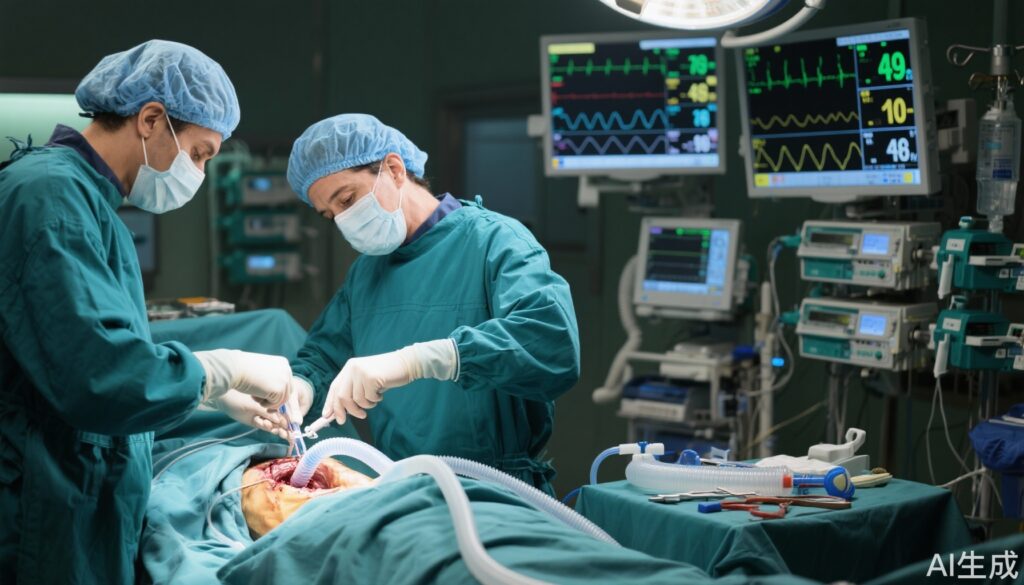Study Background and Disease Burden
Oesophagectomy remains a cornerstone in the curative treatment of oesophageal cancer, a malignancy associated with significant morbidity and mortality worldwide. The procedure itself is complex and carries a high rate of postoperative complications, with anastomotic leak being one of the most severe and clinically challenging. Managing postoperative care to minimize complications is critical, and routine nasogastric (NG) tube placement for gastric decompression has been a standard practice to potentially reduce risks such as leak and aspiration.
However, the use of NG tubes is being increasingly questioned due to discomfort, risk of infection, and delayed recovery. Some centers have started abolishing routine NG tube use postoperatively, but robust evidence guiding this practice has been lacking. Against this background, the Nordic multicentre randomized controlled trial was designed to rigorously evaluate whether omitting the NG tube post-oesophagectomy was non-inferior to maintaining it for five days with regard to the risk of anastomotic leak.
Study Design
This open-label, non-inferiority randomized controlled trial was conducted across 12 hospitals in Sweden, Norway, Denmark, and Finland involving patients undergoing oesophagectomy for oesophageal or gastroesophageal junctional cancer. Participants were randomised in a 1:1 ratio to either no postoperative NG tube or to five days of NG tube decompression.
The primary endpoint was the incidence of anastomotic leaks, a crucial factor influencing postoperative morbidity, mortality, and long-term outcomes. Secondary endpoints included pneumonia incidence and length of hospital stay, important markers of recovery and healthcare resource utilization. Non-inferiority margin for anastomotic leak was pre-specified as a risk difference of less than 9%. Analyses were performed on intention-to-treat and per-protocol populations. The trial was registered with ISRCTN and funded by the Swedish Cancer Society and the Nordic Cancer Union.
Key Findings
From January 2022 to March 2024, 448 patients were enrolled and randomized—217 to no NG tube and 231 to the NG tube group. The demographic profile included an average age of 67.5 years and a predominance of male patients (81.9%).
The primary outcome demonstrated that non-inferiority of no NG tube use could not be established. Anastomotic leak occurred in 22.1% of patients without NG tube decompression compared to 15.2% in those with five days of NG tube decompression. The risk difference was -7.0% (95% CI -14.4%, 0.00%), with a non-inferiority p-value of 0.30, indicating no statistical confirmation that removing NG tubes was as safe regarding leak risk.
A supplementary analysis substantiated a lower risk of anastomotic leak associated with NG tube decompression. Rates of other complications, such as pneumonia, were comparable between groups, suggesting that NG tube use did not affect these outcomes adversely.
Per-protocol analyses further emphasized a protective effect of NG tube decompression, with a risk difference favoring NG tube use by -11.3% (95% CI -19.1%, -0.3%). These findings suggest that maintaining NG decompression postoperatively may mitigate the risk of anastomotic leakage more effectively than omitting it.
Expert Commentary
These results provide valuable evidence to the longstanding clinical debate regarding postoperative gastric decompression after oesophagectomy. Although NG tubes can cause discomfort and potential complications, their role in preventing anastomotic leak appears significant based on this well-powered multicenter trial.
The inability to prove non-inferiority suggests that premature removal of NG tubes might elevate leak risk, a complication associated with substantial morbidity and mortality. Current international guidelines and expert consensus often support NG tube use as a precautionary measure, yet practices vary widely. This study reinforces the need to retain NG tube decompression at least during the early postoperative period after oesophagectomy.
Limitations of the study include its open-label design, which may introduce performance bias, although the objective nature of primary outcomes mitigates this concern. The study population was representative, spanning multiple Nordic centers, enhancing generalizability to similar healthcare settings. Future research might explore optimized NG tube protocols balancing risk reduction and patient comfort or assess alternative decompression strategies.
Conclusion
This rigorously conducted Nordic multicentre trial demonstrates that omission of postoperative nasogastric tube decompression after oesophagectomy cannot be considered non-inferior to standard five-day NG tube use in terms of anastomotic leak risk. The findings indicate a higher incidence of leak without NG tubes, thereby supporting continuation of routine NG tube decompression postoperatively to maximize surgical safety.
Clinicians should weigh the benefits of leak prevention against NG tube-related discomfort and tailor postoperative management accordingly, but this study provides robust evidence favoring continued NG tube use to reduce one of the most serious oesophagectomy complications.
References
Hedberg J, Kauppila J, Aahlin EK, et al. Nasogastric tube after oesophagectomy and risk of anastomotic leak: a Nordic, multicentre, open-label, randomised, controlled, non-inferiority trial. Lancet Reg Health Eur. 2025 Jul 31;57:101411. doi: 10.1016/j.lanepe.2025.101411. PMID: 40799505; PMCID: PMC12337195.


